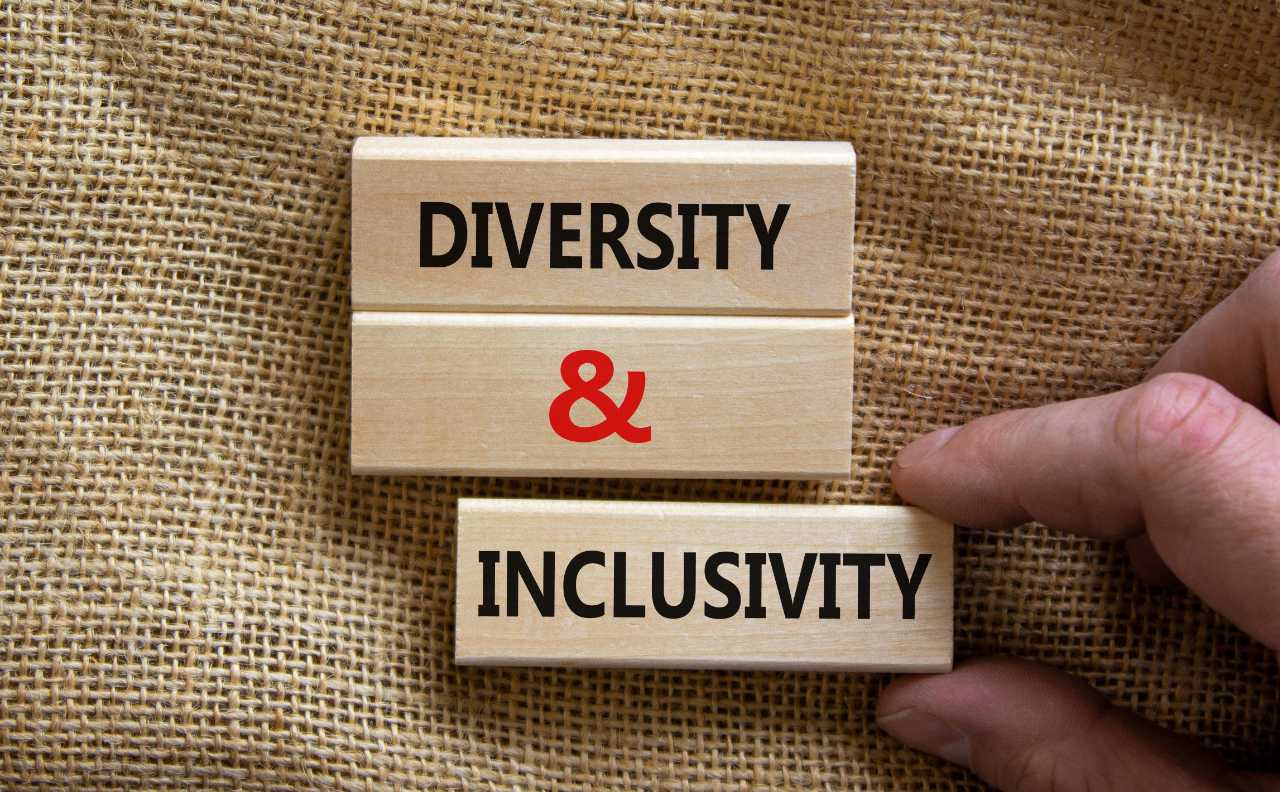
Promoting equality and diversity in the workplace is about creating an inclusive environment that benefits employees, organisations, and society.
Organisations are increasingly adopting strategies like blind CV reviews to ensure fair and equitable hiring processes. However, studies reveal there is still significant room for improvement in equality, diversity, and inclusion (ED&I) efforts across industries.
For example, the McGregor-Smith Review highlighted that employment rates for Black, Asian, and other ethnic minority individuals were 62.8%, compared to 76.5% for white workers. Furthermore, research from Workday shows only 35% of leadership teams consider ED&I essential, with over a third lacking a formal strategy.
Here is our comprehensive guide to fostering diversity and equality in the workplace to create opportunities for personal growth and drive your organisation’s long-term success.

What is equality and diversity in the workplace?
Equality
Equality in the workplace refers to equal job and career development opportunities for all employees and job applicants. This means that no individual is prevented from filling a suitable role or progressing their career because they have certain characteristics, such as race, age or gender.
Discrimination against an individual based on the nine protected characteristics in the Equality Act 2010 is against the law. The nine protected characteristics are:
- Age
- Disability
- Gender reassignment
- Marriage and civil partnership
- Pregnancy and maternity
- Race
- Religion or belief
- Sex
- Sexual orientation
Diversity
Diversity in the workplace encompasses the variety and diversity of employees’ backgrounds, such as schooling, community, beliefs, lifestyle and other characteristics.
Why is equality and diversity important in the workplace?
Diversity in the workplace means employing people from a wide pool of backgrounds, characteristics, demographics, and behaviours to ensure a wide range of views, experiences, and perspectives.
Diversity and equality in the workplace are an asset for any organisation, but it can feel difficult to know where to begin to improve your workplace culture. Our Equality and Diversity for Managers eLearning training course provides managers with the knowledge to foster diversity, address unconscious bias and ensure compliance with legislation.
5 benefits of equality and diversity in the workplace
There are many ways organisations benefit from a diverse, equal and inclusive workforce:
Greater variety of skills and experience
Teams comprised of individuals from different backgrounds may benefit from a wider variety of viewpoints, experiences and skills.
This diversity of skills and experience can lead to an increase in organisational performance and output, with diverse teams making better business decisions 87% of the time. For example, an older team member may have already experienced a specific issue they are being tasked with addressing and fixing, allowing them to draw on previous experience to solve the problem.
Having diverse teams with broader skillsets could mean that they are more likely to be more effective when approaching new tasks and projects, boosting productivity, effectiveness and reducing waste and inefficiencies.
Develop new markets
By promoting diversity and equality in the workplace, organisations can open themselves up to new market possibilities.
As the economy becomes increasingly globalised, it is essential to reflect this in workforce diversity, where those of different geographical, cultural and social backgrounds can offer new insight and open doors.
Diverse teams will also have the core skills you need to assess and enter new markets. Teams with relevant cultural backgrounds and experiences can help organisations understand markets, establish contacts, understand cultural norms and provide greater insight into customer needs.
From in-house language skills to experience working with different demographic groupings, this expertise and experience can save your organisation from making costly commercial mistakes or paying for external expertise.
Brand reputation
With the spotlight on how organisations are promoting diversity and equality, such as being required to publicly disclosing gender pay gap data, there is a drive from industry professionals and job seekers for more inclusive workplaces.
When individuals from a diverse range of backgrounds hold senior roles, this can have a visual impact on how other industry professionals and job seekers view the organisation. Employment platforms such as LinkedIn and Glassdoor provide a great way to encourage your workforce to share their diverse values and the benefits of your organisation.
Increased innovation
According to Forbes, organisations with above-average management team diversity produced 45% more revenue from innovation than those with below-average diversity (19%).
With a team comprised of individuals with different backgrounds and skillsets, there is a greater opportunity for collaboration and creativity.
Wider talent pools
According to a Glassdoor survey, 76% of respondents said that an inclusive workplace is a key factor when it comes to evaluating job offers and organisations. Not only does diversity and equality help attract a wide range of employees, but it also helps retain them as they feel that they are working for an organisation whose values match their own.
How to promote equality and diversity in the workplace
Organisations can foster diversity and equality through:
Inclusive recruitment practices
- Blind CV screening. Remove names, ages, and other personal identifiers from CVs to eliminate unconscious bias in the selection process.
- Structured interviews. Use a consistent set of questions and scoring criteria for all candidates to ensure comparability and objectivity.
- Inclusive job descriptions. Avoid language that might deter certain groups, such as gendered terms or jargon that could alienate individuals from non-traditional backgrounds. Highlight flexible working options and commitments to diversity to attract a broader pool of applicants.
Training and education
- Regular training. Offer mandatory training sessions for all employees, tailored to address unconscious bias, cultural competency, and the importance of inclusion.
- Manager-specific training. Equip managers with the skills to identify and mitigate biases, ensuring they foster equitable team dynamics and decision-making. See our Equality, Diversity and Inclusion Training for Managers (EID).
- Equality Act 2010 awareness. Emphasise legal responsibilities, outlining the protected characteristics and the importance of fostering an inclusive environment that adheres to legislation.
Clear policies
Transparent policies provide a framework for action and accountability:
- Anti-discrimination and harassment policies. Draft comprehensive documents outlining unacceptable behaviours, reporting mechanisms, and consequences for breaches.
- Accessibility and support. Ensure policies include reasonable adjustments for employees with disabilities and support for those facing discrimination.
- Regular communication. Policies should be communicated to all employees during onboarding and periodically revisited to maintain awareness.
Leadership commitment
Leaders set the tone for organisational culture:
- Visible advocacy. Senior leaders should actively speak about and prioritise equality and diversity, demonstrating their importance through words and actions.
- Measurable goals. Establish specific, measurable objectives for diversity and inclusion, such as increasing representation of underrepresented groups at different organisational levels.
- Accountability. Regularly review progress through diversity audits and hold leaders accountable for achieving set goals.
Employee engagement
Engaging employees ensures that diversity initiatives reflect their experiences and needs:
- Open forums and surveys. Create safe spaces for employees to share their perspectives, experiences, and ideas for improvement.
- Focus groups. Gather insights from specific groups, such as women, LGBTQ+ employees, or minority ethnic employees, to address their unique challenges and opportunities.
- Acting on feedback. Use the insights gathered to inform policy changes, training needs, and strategic planning, showing employees their input is valued and impactful.
Equality and diversity in the workplace examples
One effective approach is offering flexible working arrangements. These arrangements can help employees balance their professional and personal responsibilities, such as caregiving. This not only supports those with family obligations but also enhances workplace morale and productivity by recognising and accommodating individual needs.
Implementing mentorship programmes for underrepresented groups is a powerful way to promote equality. This can be set up by partnering with educational institutions or job boards that focus on under-represented communities. These programmes can provide guidance, support, and opportunities for career development to employees who may face systemic challenges in advancing their careers.
Another example is advertising jobs to attract a broad range of people. Using gender-neutral and inclusive language in job postings to attract a more diverse pool of candidates and avoid deterring applicants from under-represented groups.
Equality and diversity in the workplace training
Investing in equality and diversity in the workplace training ensures employees and leaders understand their responsibilities and rights, fostering a culture of inclusion.
Our Equality, Diversity and Inclusion Training for Managers enables team leaders to develop the skills to foster a culture in which every employee feels valued which benefits the organisation and supports compliance with the Equality Act 2010.
We also offer Inclusion, Equality and Diversity Training for all employees which enables them to help create a supportive, inclusive working environment for everyone.
Find out more about these courses on our website or talk to our friendly team today on 0203 011 4242/info@praxis42.com


Tom Escobar
Director of Services & Training
